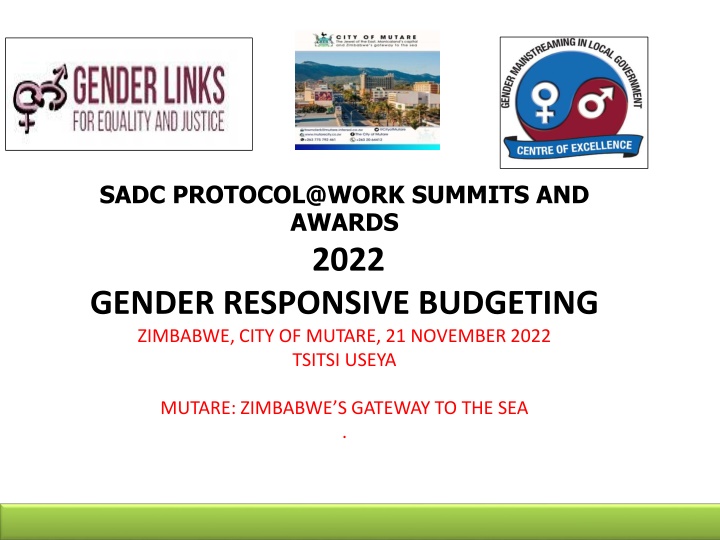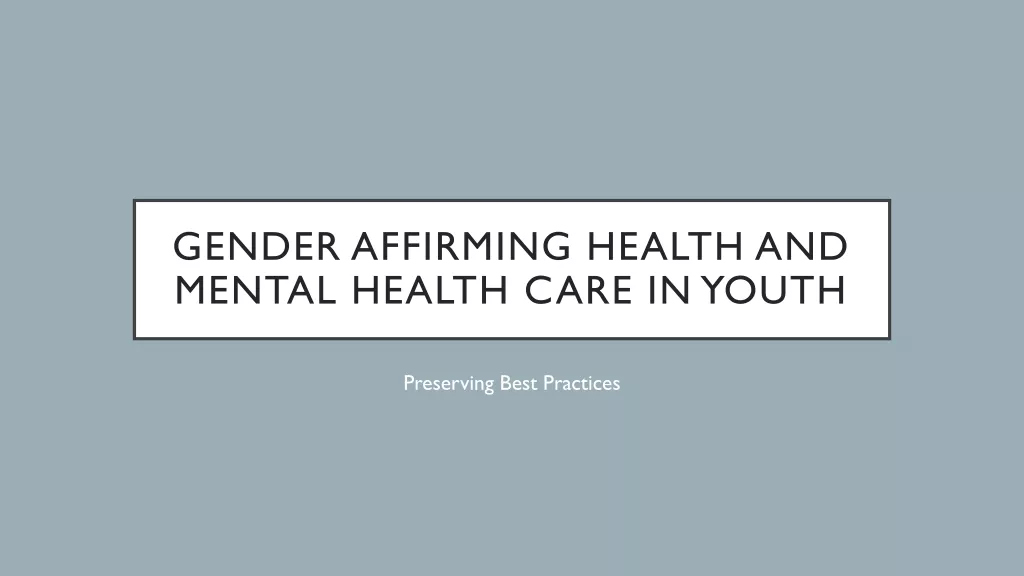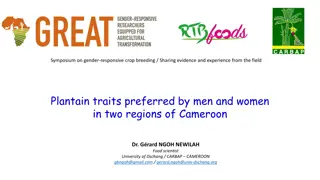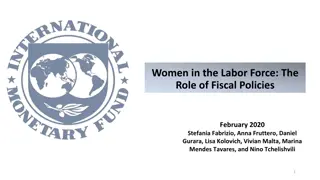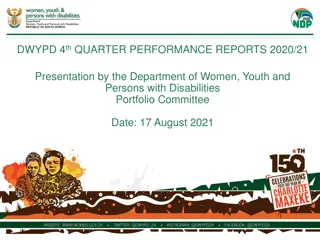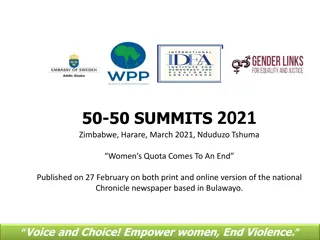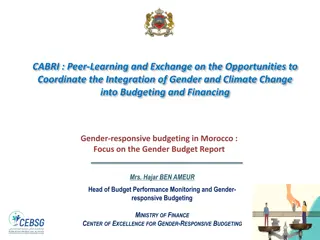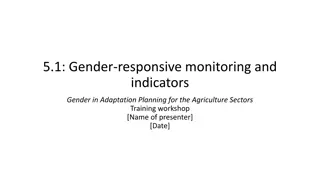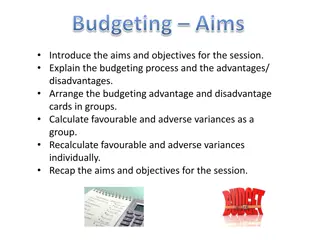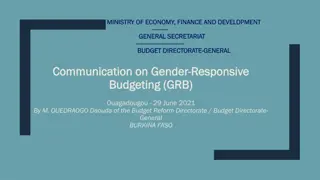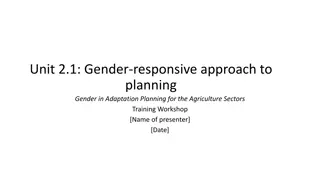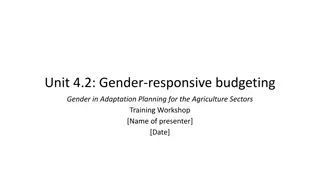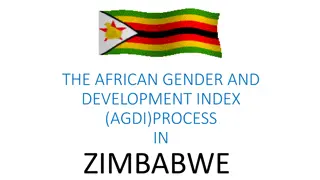Gender-Responsive Budgeting in Zimbabwe: A Case Study of Mutare City Council
The City of Mutare in Zimbabwe is implementing gender-responsive budgeting as per the SADC Protocol on Gender and Development. The council has a gender policy ensuring inclusivity in budgeting, guided by national policies and frameworks. Stakeholders, including women, youth, and people with disabilities, actively participate in the budget process, utilizing various consultation methods for engagement. The council's commitment to digitalization enhances transparency and inclusivity.
Download Presentation

Please find below an Image/Link to download the presentation.
The content on the website is provided AS IS for your information and personal use only. It may not be sold, licensed, or shared on other websites without obtaining consent from the author.If you encounter any issues during the download, it is possible that the publisher has removed the file from their server.
You are allowed to download the files provided on this website for personal or commercial use, subject to the condition that they are used lawfully. All files are the property of their respective owners.
The content on the website is provided AS IS for your information and personal use only. It may not be sold, licensed, or shared on other websites without obtaining consent from the author.
E N D
Presentation Transcript
SADC PROTOCOL@WORK SUMMITS AND AWARDS 2022 GENDER RESPONSIVE BUDGETING ZIMBABWE, CITY OF MUTARE, 21 NOVEMBER 2022 TSITSI USEYA MUTARE: ZIMBABWE S GATEWAY TO THE SEA .
OVERVIEW COUNTRY COUNCIL (HUB/SPOKE) GENDER CHAMPION GENDER FOCAL PERSON Latest score (year) ZIMBABWE HUB Councillor Sophia Rudo Gwasira CHRISTINA MABIKA 88 (2021) Expenditure % Gender Specific Income Budget (YEAR) 62 582 976 62 582 976 Men 1.41 Total Women % Women 29% Council 34332 8392 11824 Management Council staff overall 649 796 954 668 1 604 464 41% 6 168 738 11 840 729 18 009 467 34% Population served Total population as per 2022 census is 224 802. Council serves a day population of around 300 000- 350 000. Key characteristics Mutare is the capital of Manicaland province and covers an area of approximately 16 900 hectares with at least 55 000 rateable properties (industry, commercial, residential and institutional).
I. POLICY FRAMEWORK Gender provisions and policies that guide the council budget are: National Gender Policy, Constitution National Development Strategy 1, SADC Protocol on Gender and Development CEDAW SDGs, City of Mutare Gender Policy, The African Union(AU) Gender Policy. Council has a gender policy which ensures gender inclusivity in catering for the needs of men and women in all Council activities and budgeting of Zimbabwe,
II. THE BUDGET PROCESS Council appointed a budget committee in which all stakeholders are included which include the Youth, Women groups, People with disability, Education sector, small and medium enterprises, Residents Associations and informal Sector. The committee is involved in the budget preparation by submitting the needs of the sectors which they represent. Council used various methodologies during the budget consultation process which include ward based consultations, Whatsapp Chatbot and other sector based stakehoders Council used advertisements through the press and radio air time, public notices, hailers, and exhibitions on the Manicaland Agricultural Show and October Summer Festival hosted by Zimpapers. In all consultations, the ward based and stakeholder groups, participants were involved in choosing the venue and time which is strategic. Council has a drive for digitalization thus various technologies such as Whatsapp groups, Chatbot, radio programs were used. In all consultations women were encouraged to participate. Women, the Youth and People with disabilities were consulted as a group and they are also represented in the budget Committee.
II. THE BUDGET PROCESS Does the council have sex/age/PLWD statistics on those who participated in the consultations? refer to consultation registers and populate table below Con sult atio n Women Tot al Men Tot al % Wo me n Age Age - 15 15- 35 36- 59 60+ PW D - 15 15- 35 36- 59 60+ PW D 10 332 360 91 13 806 13 133 245 291 12 694 54 % 1 41 45 11 2 100 % 2 19 35 42 2 100 % Voice and Choice! Empower Women, End Violence .
III. REVENUE Internal revenue constitutes 43% while external sources of funding constitute 57%. Gender considerations: Quota systems provided for in various in various Council policies, the need to make resources such as water available. The issue of street lighting was informed by the need to reduce cases of Sexual Gender Based Violence, How were these decisions influenced by budget consultations, in particular the views of women? The external financing specifically targeted at gender is the Gimboki Primary School which will make education accessible as well as the Hobhouse Primary School Sources of Funding for Mutare City Council 43% 57% INTERNAL EXTERNAL
IV. EXPENDITURE Insert Pie Chart/Table Gender System: 1% Salaries: 28% Employment equity-related expenditure: 1% Gender-specific programmes: 1.4% Mainstream programmes: 57% Management City of Mutare Expenditure 0% 13% 29% 1% 0% 57% Gender management System(GMS) Employment expenditure (Human Capital) Employment equity related expenditure Gender Specific Programming Mainstream Programmes Other
IV. EXPENDITURE Type of Expenditure Amount Proportion (%) Gender Management System (GMS) 94 274 1 Employment expenditure (Human Capital Expenditure) 18 009 467 28 Employment equity related expenditure 128 189 1 Gender Specific Programming 884 134 1.4 Mainstream Programmes 35 520 878 56 Other 7 946 035 27 Total 62 582 976 100
IV. EXPENDITURE- GMS Council has a Gender Management System, comprising of Gender Management Team, Gender Focal Person, Departmental Gender Focal Persons and Gender Champion. GMS activities budgeted for include Gender Committee meetings, Training, Policy formulation, Exchange visits. The budgets are found under the Governance and Social Services programmes and during budget implementation they have their own vote
IV. Gender Specific expenditure Council has the following gender-specific programmes:- Commemorations Training Junior Council Women in Local Economic Development The budget lines are found aunder the Governance and Social Services ? Are they visible? 1.4% is allocated for gender-specific programming During budget consultations residents pointed out the need for the recognition of the elderly, the poor, PWD, youth (education grant) and for women who are under priviledged or survivors pf GBV The programmes will help the above mentioned groups as some will be receiving rates rebates, educational grants as well as disability friendly infrastructure
IV. EMPLOYMENT EXPENDITURE Women Men Total % women Mana gers Staff Total Mana gers Staff Total Mana gers Staff Total Full Time 7 375 382 12 794 806 1188 0.59 32% 32% Part time 0 0 0 0 0 0 0 0 0 0 Casual 0 194 194 0 321 321 515 0 38% 38% Total 7 549 576 12 1084 1127 1703 0.59 69% 70% Women comprise 34% of the workforce. The percentage of women in management less than 1% that is 0.41% Women in of the full time employment comprise 22% , and those in casual, labour force comprise 11% of the overall workforce.
IV. EMPLOYMENT EXPENDITURE- Gender Wage Gap Analysis Women Women- Total earned earned Women average Men-no Men total earned Average earnings Full Time 382 4774 631 12499 806 9500640 11787 Part Time 0 0 0 0 0 0 Casual 194 1394106 7186 321 2340089 7290 Total 576 6168738 10710 1127 11840729 10506 The average earnings for men is $10 506 and that of women is $10 710 There is no wage gap, the average earnings for men is lower than that of women. Employees in the same grade are paid the same salary regardless of gender. The average earnings shows that more women are employed in the supervisory level to middle management positions while most men are employed in low paying jobs.
V. EXPENDITURE- GENDER IN MAINSTREAM BUDGET Programmes Amount % budget Expenditure by Programme 2% 12 117 590.00 19.36% Governance & Administration 19% 9 712 513.00 15.57% Water Sanitation & Hygiene 37% 16% 9 493 006.00 15.17% Social Services 6 821 414.00 10.9% Roads 15% 11% 23 088 262.00 36.84% Public Safety & Security Governanceand Administration 1 350 463.00 2.16% Natural Resources & Conservation Water ,Sanitation and Hygiene Social Services Roads Public Safety and security 62 582 976.00 100% Total Natural Resources and Conversation
V. EXPENDITURE- ANALYSIS OF ONE SECTOR EG Women Age 36-59 60+ PLW Men Age Belo w 15 Belo w 15 517 6 0 250 97 302 73 60+ PLW 15- 35 Tot al 51 53 16 43 301 48 470 15- 35 136 36- 59 10 Tot al 53 33 41 76 167 81 541 D 2 D 11 Education 5087 59 0 0 7 0 9522 207 0 95 15 4 358 37 Housing Social amenities Total 4 12 1291 5 1293 4 0 15 235 91 237 42 22 270 84 271 16 0 54 208 17 1460 9 95 17 362 48
V. EXPENDITURE- GENDER IN MAINSTREAM BUDGET Council is ensuring that women and men, boys and girls benefit equally by implementing projects that cover gaps that created the disparities in the first place. The 2022 Social services budget s main thrust was establishing and revamping markets. In 2023, the Council Capital Expenditure budget is focusing on public lighting with a view to reduce Sexual Gender Based Violence and City wide water augmentation which will make water more accecible to residents especially women.
V. EXPENDITURE- GENDER IN MAINSTREAM BUDGET EXAMPLE No of beneficiaries Percent age Housing Amount Total Housing Expenditure No. of Men benefiting from council allocations No. of Women benefiting from council allocations Total beneficiaries 2 353 195 216 72% 84 28% 2 353 195 300 100
VI. BUDGET CROSS SUBSIDISATION ANALYSIS Income (A) % of total budget Expenditure (B) % of total budget Surplus/Defi cit Governance & Administratio n 6131481 10 12117590 19 -5986109 Water, Sanitation & Hygiene 22516261 36 9712513 16 1203748 Social Services 6176405 10 9493006 15 -3316601 Roads 2938307 5 6821141 11 1532195 Public Safety and Security 24620457 39 23088262 37 2532195 Natural Resources & Conservation Mgt 200064 0 .32 1350463 2 -1150399 Total 62582976 100 62582976 100 0
VI. BUDGET CROSS SUBSIDISATION ANALYSIS Some programmes have deficits for example Natural resources, Governance, Roads and Social Services while some programmes like Water Sanitation and Hygiene, Public safety and Security have surplus thus financing other programmes. Water, Sanitation and Hygiene and Public Safety and Security have a surplus. The following programmes spend more than they generate:- Governance , Roads and Social Services. The provision of health care and roads receive subsidies from Public Safety and Security were part of the rates finance the Public Safety and Security programme. In Governance administration work receive subsidies from Water , Sanitation and Hygiene since the salary for all skilled employees who are not directly involved in the real work of service delivery (for example ferrying of refuse bins) is charged to Governance. (i.e. they are being subsidized) Voice and Choice! Empower Women, End Violence .
VII. CONCLUSIONS AND NEXT STEPS The Council budget has benefited women through women empowerement programmes, School fees bursary in the Gender Specific Budget as well as projects in the Gender Related Budget such as City Wide water and street lighting augmentation, Gimboki Primary School and Hobhouse Clinic There is a need to increase the Gender Related budget and to specifically budget for Hub and Spoke Programmes Voice and Choice! Empower Women, End Violence .
